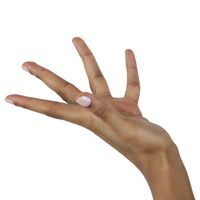Difference between revisions of "Alapadma"
Jump to navigation
Jump to search
(Application and Description Added) |
(cleaned up original text) |
||
| Line 5: | Line 5: | ||
}} | }} | ||
| − | '''Alapadma''' | + | '''Alapadma''' mudra, according to legend, originated from a story about Shri Krishna as a child, in which he stole butter and milk. |
| − | + | ==Application== | |
| − | + | Alapadma mudra is one of the many hand gestures used by performing artists to interpret an emotional or physical state. | |
| − | + | This gesture can also be used for the following: | |
| − | + | * Viraha ("yearning for the beloved") | |
| − | + | * Mukura ("mirror") | |
| − | + | * Tataka ("pond" or "lake") | |
| − | + | * Udra-thakopa ("great anger") | |
| − | + | * Shakata ("cart") | |
| − | + | * fresh ghee | |
| − | + | * sweets | |
| + | * ball | ||
| + | * dancing | ||
| + | * palace | ||
| + | * cluster of flowers | ||
| − | |||
[[Category:Mudras]] | [[Category:Mudras]] | ||
Revision as of 09:52, 6 July 2013
| Meaning | Fully opened lotus |
|---|---|
Alapadma mudra, according to legend, originated from a story about Shri Krishna as a child, in which he stole butter and milk.
Application
Alapadma mudra is one of the many hand gestures used by performing artists to interpret an emotional or physical state.
This gesture can also be used for the following:
- Viraha ("yearning for the beloved")
- Mukura ("mirror")
- Tataka ("pond" or "lake")
- Udra-thakopa ("great anger")
- Shakata ("cart")
- fresh ghee
- sweets
- ball
- dancing
- palace
- cluster of flowers
